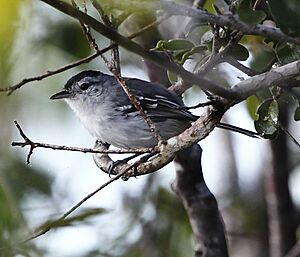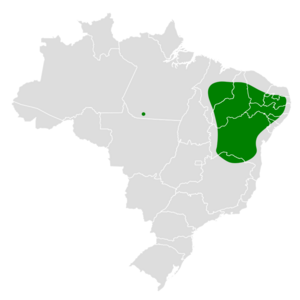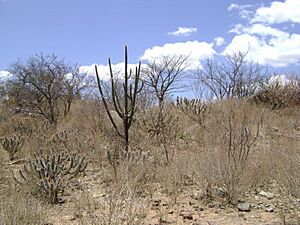Caatinga antwren facts for kids
Quick facts for kids Caatinga antwren |
|
|---|---|
 |
|
| Male Caatinga antwren in Crato, Ceará | |
| Conservation status | |
| Scientific classification | |
| Genus: |
Radinopsyche
|
| Species: |
sellowi
|
 |
|
| Synonyms | |
|
Herpsilochmus sellowi Whitney, Pacheco, Buzzetti & Parrini, 2000 |
|
The Caatinga antwren (scientific name: Radinopsyche sellowi) is a small bird found only in Brazil. It belongs to a family of birds called "typical antbirds". This bird is special because it lives mainly in the Caatinga, a unique dry forest region in northeastern Brazil.
Contents
About the Caatinga Antwren
How Scientists Name and Classify It
For many years, the Caatinga antwren was thought to be part of another bird species. But in 2000, scientists studied it closely. They found it was different enough to be its own species.
Later, in 2021, more research showed that this bird didn't fit with its old group. So, scientists created a brand new group, or genus, just for it. They named this new genus Radinopsyche. Most big bird organizations now use this new name.
The English name "Caatinga antwren" comes from its main home, the Caatinga forest. Its scientific name, sellowi, honors a scientist named Friedrich Sellow. He collected many birds and other natural items in eastern Brazil a long time ago.
The Caatinga antwren is the only bird in its genus. This means it's quite unique! It does not have any different types or subspecies.
What Does the Caatinga Antwren Look Like?
The Caatinga antwren is a small bird. It is about 10.5 to 11.5 centimeters (4.1 to 4.5 inches) long. It weighs about 6.5 to 8 grams (0.23 to 0.28 ounces). That's about the weight of two pennies!
Male Caatinga antwrens have a black cap on their head. They have white stripes above their eyes and a gray face. Their back is mostly gray. They have black wings with white edges and a black tail with white tips. Their belly is a light gray-white.
Female Caatinga antwrens look similar to males. But their colors are a bit softer. Their forehead feathers have a dull, light brown edge. Their back has a slight olive green tint. Their belly is also a pale, light brown color.
Where Do Caatinga Antwrens Live?
The Caatinga antwren lives in north-central and eastern Brazil. You can find it in states like Pará, Maranhão, Rio Grande do Norte, Bahia, and northern Minas Gerais.
As its name suggests, it mostly lives in the Caatinga. This is a special dry forest found only in northeastern Brazil. It prefers woodlands where trees lose their leaves part of the year. It also likes areas where the Caatinga meets another type of forest called cerrado.
These birds usually avoid very wet forests or very dry, scrubby areas. They are typically found at heights between 300 and 900 meters (980 and 2,950 feet) above sea level. Sometimes, they can be seen as high as 1,100 meters (3,600 feet).
Caatinga Antwren Behavior
Staying in One Place
Scientists believe the Caatinga antwren stays in the same area all year round. It does not migrate to other places.
What and How They Eat
The Caatinga antwren eats mostly insects and spiders. It hunts for food alone, in pairs, or in small family groups. Often, it joins groups of different bird species that are feeding together.
These birds usually look for food in the middle and upper parts of trees. They can go up to about 12 meters (39 feet) high. However, at the edges of woodlands, they might feed as low as 1.5 meters (5 feet) from the ground.
They hop through the branches and leaves. They pick insects and spiders off leaves and stems. Sometimes, they make short jumps from a branch to catch prey. They have not been seen following swarms of army ants, which some other antbirds do.
Breeding Habits
Not much is known about how Caatinga antwrens raise their young. Scientists have only seen young birds that were almost ready to fly in February. More research is needed to understand their breeding habits.
Sounds and Songs
The Caatinga antwren's song is a "very high, short, fast rattle." It sounds like "wrrrrrru." The song starts a bit higher and then gets lower at the end.
It also makes a call that is a short, repeated "wiip" sound. Another call is a one-second rattle. This rattle is usually preceded by a slightly longer, downward-sloping note and then rises in pitch.
Status of the Caatinga Antwren
The International Union for Conservation of Nature (IUCN) keeps track of how endangered animals are. In 2002, they first listed the Caatinga antwren as "Near Threatened." This meant it might become endangered soon.
However, in 2011, they changed its status to "Least Concern." This means it's not currently at high risk of extinction. Even though it has a large home range, it's not found everywhere within that area. Its population size is unknown, but scientists believe it is decreasing.
The Caatinga antwren's home is facing challenges. People are changing its habitat for farming, ranching, and oil drilling. But the good news is that this bird can live in areas that have been slightly changed by humans. It is considered uncommon to fairly common in its range. It also lives in at least three protected areas, which helps keep it safe. However, most of its habitat is not protected.



